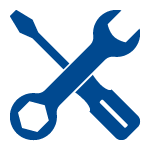We provide scheduled maintenance for your car or truck. Stay on track with our auto service team by scheduling a vehicle belts & hoses inspection today.
Understanding belts
While some accessories in your car are electrically powered by the charging system, others use the engine itself as their power source. The power for these accessories is delivered by a system of pulleys and belts. Examples of these accessories include:
Alternator
Water pump for engine cooling
Power steering pump
Radiator cooling fan
Understanding hoses
The hoses that convey your car’s fluids are made of two rubber layers with a layer of fabric in between. Typical hoses include:
Radiator and heater hoses, which convey coolant to the engine
Fuel hose, which transports gas from the tank to the engine
Power steering hose, which connects the power steering pump to the steering gear
Brake hose, which establishes a flexible connection between brake pipes and the wheel brakes to enhance the efficiency of braking systems



